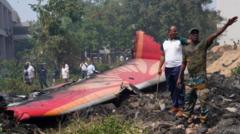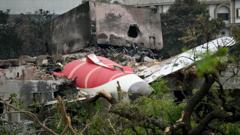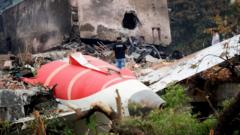The Air India Flight 171 investigation continues as experts analyze data from the Boeing 787 Dreamliner, searching for clues in a crash that occurred just 30 seconds after takeoff, raising concerns about aviation safety protocols.
Unraveling the Mystery of the Air India Flight 171 Crash

Unraveling the Mystery of the Air India Flight 171 Crash
Investigators face daunting tasks as they piece together the events leading to the tragic Air India crash, examining flight data and wreckage.
Air India Flight 171, a Boeing 787 Dreamliner, tragically crashed just moments after takeoff from Ahmedabad, India, last week, plunging into a densely populated area and sparking one of the country's most perplexing aviation investigations. The aircraft, carrying 242 individuals and nearly 100 tonnes of fuel, was airborne for less than a minute when it lost altitude, leading to a devastating crash. Investigators now have the formidable task of analyzing the wreckage and retrieving data from the cockpit voice and flight data recorders to uncover what went wrong.
Under the guidelines established by the International Civil Aviation Organization (ICAO), a preliminary report of the crash must be presented within 30 days, while a comprehensive analysis is expected to follow within a year. The aircraft was spearheaded by Captain Sumeet Sabharwal and co-pilot Clive Kundar when, shortly after takeoff at 13:39 local time, a mayday call was the final communication from the cockpit, followed by an alarming loss of altitude.
Experts describe this incident as "the rarest of the rare," indicating an extraordinary scenario where a controlled flight transitioned into terrain contact almost instantaneously. Investigators are examining various factors, including potential bird strikes, fuel contamination, mechanical malfunctions, or human error, which might have caused engine failure or inadequate lift.
As part of the investigation, wreckage from the crash scene will be meticulously analyzed. Every significant component, from chards of damaged turbines to the minute details of the aircraft's maintenance logs, will be methodically scrutinized for clues. The focus will likely trail to the aircraft's engines, providing insights into whether they were operational at the time of the crash.
The substantial data collection from the Boeing 787's Enhanced Airborne Flight Recorders will play a critical role in determining the circumstances preceding the disaster. These recorders capture vital information regarding the flight's performance, pilot actions, and environmental noises, aiding investigators in reconstructing the flight's final moments.
While it remains unclear whether the cause of the disaster lies within the aircraft systems or pilot error, close collaboration between the Indian Aircraft Accident Investigation Bureau, Boeing, engine manufacturers, and international aviation bodies is already underway. The complexity of aviation investigations means that while initial indicators may surface quickly, a thorough understanding of the underlying causes may require extensive time and analysis, a crucial endeavor that aims to enhance global aviation safety moving forward.
As experts caution against jumping to conclusions regarding culpability, the Indian civil aviation ministry emphasized that recent inspections of Air India’s fleet revealed no immediate safety concerns. This accident highlights the need for meticulous investigation procedures that embrace modern technological advancements which allow for exhaustive data capture, thus evolving the standards of aviation safety and operational transparency.





















